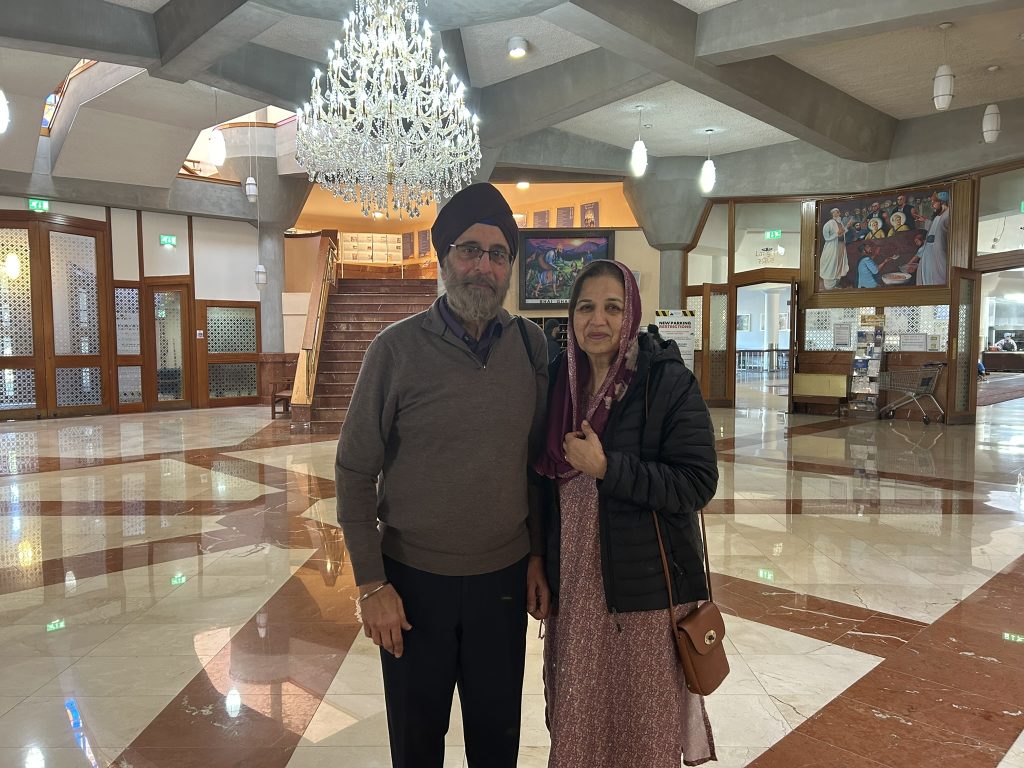“In Punjabi, seva means selfless sacrifice and is a key principle of Sikh culture: to commit oneself, to offer one’s work and to dedicate oneself to others without expecting anything in return”. Tyron, who works as a security guard at the main Sikh temple in London, explains it. The Sikhs are a religious community from Punjab, India, hugely present abroad due to local political and religious tensions.
In Europe, the largest presence is registered in England. Arriving on the purple Elizabeth Railway Line, the first thing that can be noticed are the signs of the suburban district of Ealing, where the writing “Southall” is accompanied by a translation in Punjabi. This district, in fact, is known as “Little India” or “Little Punjab”, due to the strong presence of the Asian community.
Here stands one of the largest gurdwaras outside India and the main one in London. It is called Gurdwara Sri Guru Singh Sabha, inaugurated in 2003. The word gurdwara comes from Punjabi and literally means “door of the Guru” (the teacher).
After going up the entrance steps, there are two doors: on the right for women and on the left for men. At the doorway Manohar, 72, is waiting for a group of students: he is a volunteer at the Gurdwara and gives lessons to the students. “When you enter, you have to wash your hands, cover your head and go barefoot” he explains.
Manohar is accompanied by his wife, Majilit. She is also a volunteer at the temple: she helps in the kitchen, and, in another Gurdwara, she teaches Punjabi on Sundays. Majilit is 69 years old and, since she retired three years ago, she has been involved in volunteering within the community. “Sikhism is based on three principles: work hard, pray and share,” he explains.
Manohar and Majilit come from Uganda, where many Sikhs were moved by British colonists in the 19th and 20th centuries to build the Uganda-Kenya railway. Manohar’s father was among them, having moved to the African country in 1940. In 1972, Ugandan dictator Idi Amin expelled the Sikhs and other Asian communities, accusing them of controlling the country’s economy. Many, with British passports, took refuge in the United Kingdom and Canada. It was then that Majilit followed Manohar to London, where he was studying. Here they built a new life and a family, without ever forgetting their origins.

In the late morning, the school group arrives and begins the tour, discovering the corridors of the gurdwara and the Sikh religion. “The children come to learn the fundamentals of Sikhism,” explains the teacher Sanah. “We teach children to compare religions, to recognize similarities and differences to learn respect,” she explains. The students, who have been made to wear yellow reflective jackets, are then led towards the kitchens.
Here there is a langar service, the community canteen where food is distributed free of charge everyday thanks to the work of volunteers. Some cooks prepare chapati, the flat and circular bread. Other volunteers take care of cooking daal, the lentil soup with spicy curry, and preparing tea.
Passing through the langar, the boys walk next to the diners who sit on carpets in front of their trays. “Here even if you are a king you sit with the others” explains Manohar. Going up the stairs there is the main hall, where the sacred scriptures are recited, and religious songs are enacted.
In a room upstairs, Manohar reveals to the children the principles of Sikhism. Born in 1469 with Guru Nanak, it is a relatively young religion compared to others such as Hinduism or Christianity. “Sikhs recognize ten Gurus, five of whom died defending their people. The history of the religion is marked by martyrs who sacrificed their lives to protect others,” he explains.
Guru Nanak was the founder of Sikhism and the first of the Gurus; he also taught the three fundamental principles of the religion: working honestly, praying and sharing with others. “There are 5 elements that characterize the Sikh believer,” continues Manohar: “The first is kesh, letting the hair grow and gathering it in the turban. It’s like a crown that can be worn at any time.” Sikhism wanted to go beyond the caste separations imposed by Hinduism. The other four symbols are a small wooden comb, an iron bracelet, a special underwear and a dagger, “because Sikhs fight for others, to help them.”
Another important factor in Sikhism is the belief in karma. “Imagine wading into a river and having all the good things in the right oar and the bad things in the left oar,” is Manohar’s image. “Even if you wanted to use only the oar of good things you couldn’t get to the other side, because life requires balance. This also makes you appreciate the difficult moments in life more, which you understand are necessary.”
At the end of the visit, Manohar takes the group back to the ground floor, where he meets Tyron who works in security. Tyron explains that the Gurdwara not only cares for the local Sikh community but also provides practical help outside. “We Sikhs are only 3% of the world’s population, but our duty is to help everyone,” says Tyron. “In addition to ensuring the security of the temple, we send food and logistical support to local churches.” “The Gurdwara is open to all, every day from 5 in the morning to 9 in the evening. Anyone in difficulty can come here for a meal or help,” he concludes, as he heads back to his office accompanied by religious chants that resound throughout the temple.
Read also: Femicide in Rome: woman stabbed and found in a suitcase in the woods

